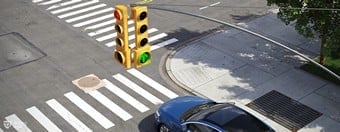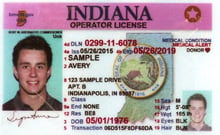

All your missed questions are saved
automatically for extra practice.




It's a practice test that's automatically made up of all your missed questions. Once you finish this test, you’ll be able to revisit your Challenge Bank™ to practice and sharpen your skills.
View All PlansAdding difficult questions to Challenge Bank™ is an exclusive Premium feature. Unlock access to 650+ exam-like questions, a Pass Guarantee, personalized study plans, and more.
View All PlansFree Indiana BMV Permit Practice Test 2025
| 90-100 | => | 8% |
| 80-89 | => | 15% |
| 70-79 | => | 21% |
| 60-69 | => | 23% |
| <60% | => | 32% |
To get your Indiana BMV learner’s permit, you must be at least 15 years old and pass a vision screening and the written permit knowledge test. If under 16, you’ll also need to enroll in a BMV-authorized behind-the-wheel training program. The test includes 50 multiple-choice questions covering material outlined in the state’s Indiana BMV 2025 Driver’s Manual. To pass, you must score at least 80% (40 out of 50 questions). There are online testing options for those under 21. Failing the test requires a retest fee, and after the third attempt, a two-week waiting period applies. Using our drivers’ practice tests ensures that doesn’t happen. Use our free online Indiana BMV permit practice Test, updated for December 2025, as test study guides. It mimics real exam conditions, providing immediate feedback to speed the learning process. The learner’s permit is the first phase of Indiana’s Graduated Driver’s License (GDL) program for drivers under 18. To apply, you must be at least 15 years old and enrolled in a driver’s education course. Without driver’s education, you’ll have to wait until you’re 16. With a permit, you can drive with a licensed driver (age 25+) or a spouse (age 21+). You must log 50 hours of supervised driving, including 10 at night. At 16 years and 90 days old (with driver’s ed) or 16 years and 270 days old (without), you can take a driving skills test for a probationary license, which has nighttime and passenger restrictions. After 180 days and reaching 18 years of age, you can apply for an unrestricted driver’s license.


How to use this practice test
- Start here. Take this short practice test and read the explanations as you go. This is one of 4 free Indiana practice tests available on our site. Avg. finish time: 6 min.
- Cover more ground. Take all tests (different questions - no-repeats across sets).
- Finish strong. Try the Exam Simulator for a full-length, exam‑style run.
Why this works
- Exam-like questions. Built from the current handbook + patterns recent test-takers report. These questions reflect what's actually being asked at the BMV right now. Explanations cite the BMV handbook section.
- On-question help. AI Assistant explains tricky items in plain language.
- Performance Insights. See your weak topics and what to study next.
Actual BMV permit test: What to expect?
- Where: Any Indiana BMV office (find locations)
- Bring: ID + SSN + residency proof + permit/license fee (see checklist)
- If you fail: Retake after 1 day.
- Commonly missed: emergency vehicle right-of-way, roundabouts and lane usage.
- Ready to schedule? Book your IN BMV appointment
Authored and fact-checked by Steven Litvintchouk, M.S.
Chief Educational Researcher, Driving‑Tests.org (ACES member)
Last verified for accuracy on
Real Indiana drivers who passed first try
Verified student reviews • Shared with permission
About the Indiana learner permit
In Indiana, what most people call the “DMV” is officially the BMV (Bureau of Motor Vehicles).
If you’re 18 or older, most GDL phases don’t apply. You’ll still need to meet the requirements for a Learner’s Permit and pass the road skills test without GDL-mandated practice hours or driver’s education.
Once you’re ready to apply for the permit, visit the BMV with proof of identity (birth certificate, passport), Social Security card, and two proofs of residence (utility bill, bank statement). Applicants under 16 need proof of BMW-approved behind-the-wheel enrollment and, if under 18, signed consent (in person) from a parent or legal guardian. (Note: If you’re under 18, the BMV will not issue you a permit or license if you have been judged a habitual truant or dropout from school.) Submit the documents, pass a vision screening, pay the fee, and pass the official written test.
More IN BMV written exam resources
Are you in another state?
- Alabama
- Alaska
- Arizona
- Arkansas
- California
- Colorado
- Connecticut
- Delaware
- District of Columbia
- Florida
- Georgia
- Hawaii
- Idaho
- Illinois
- Indiana
- Iowa
- Kansas
- Kentucky
- Louisiana
- Maine
- Maryland
- Massachusetts
- Michigan
- Minnesota
- Mississippi
- Missouri
- Montana
- Nebraska
- Nevada
- New Hampshire
- New Jersey
- New Mexico
- New York
- North Carolina
- North Dakota
- Ohio
- Oklahoma
- Oregon
- Pennsylvania
- Rhode Island
- South Carolina
- South Dakota
- Tennessee
- Texas
- Utah
- Vermont
- Virginia
- Washington
- West Virginia
- Wisconsin
- Wyoming
We know what it takes to pass. And we’ve got the proof.
Driver’s Ed is - nobody wants to set foot inside the BMV. That’s why millions of learners trust us for simple, visual, effective prep.
An official & trusted partner in driver education
We are an officially recognized FMCSA Entry-Level Driver Training provider and a proud partner to over 2,500 libraries. We work with safety organizations like GHSA and the National Safety Council to help create safer roads for everyone.






A smarter way to study
Challenge Bank™
Our trademarked system automatically saves questions you miss, creating personalized tests that target your weak spots until you’ve mastered the material.
AI-powered feedback
Get smarter as you study. Our new AI-powered feedback provides detailed, question-level insights to help you understand the why behind each answer.
Interactive handbook
Go beyond the boring black-and-white manual. Our interactive handbook lets you read, listen with an MP3 audio version, or even chat with it to find the information you need, faster.
We build our practice questions from the current 2025 IN Driver Handbook and refine them using patterns recent test‑takers report.
Driver handbook • Knowledge‑test/permit overview • Fees & ID requirements • Office/appointment info
We mirror recurring themes (e.g., right‑of‑way traps, sign look‑alikes) and use similar distractors and wording styles.
We don’t collect or publish actual test items and we’re not affiliated with BMV.
